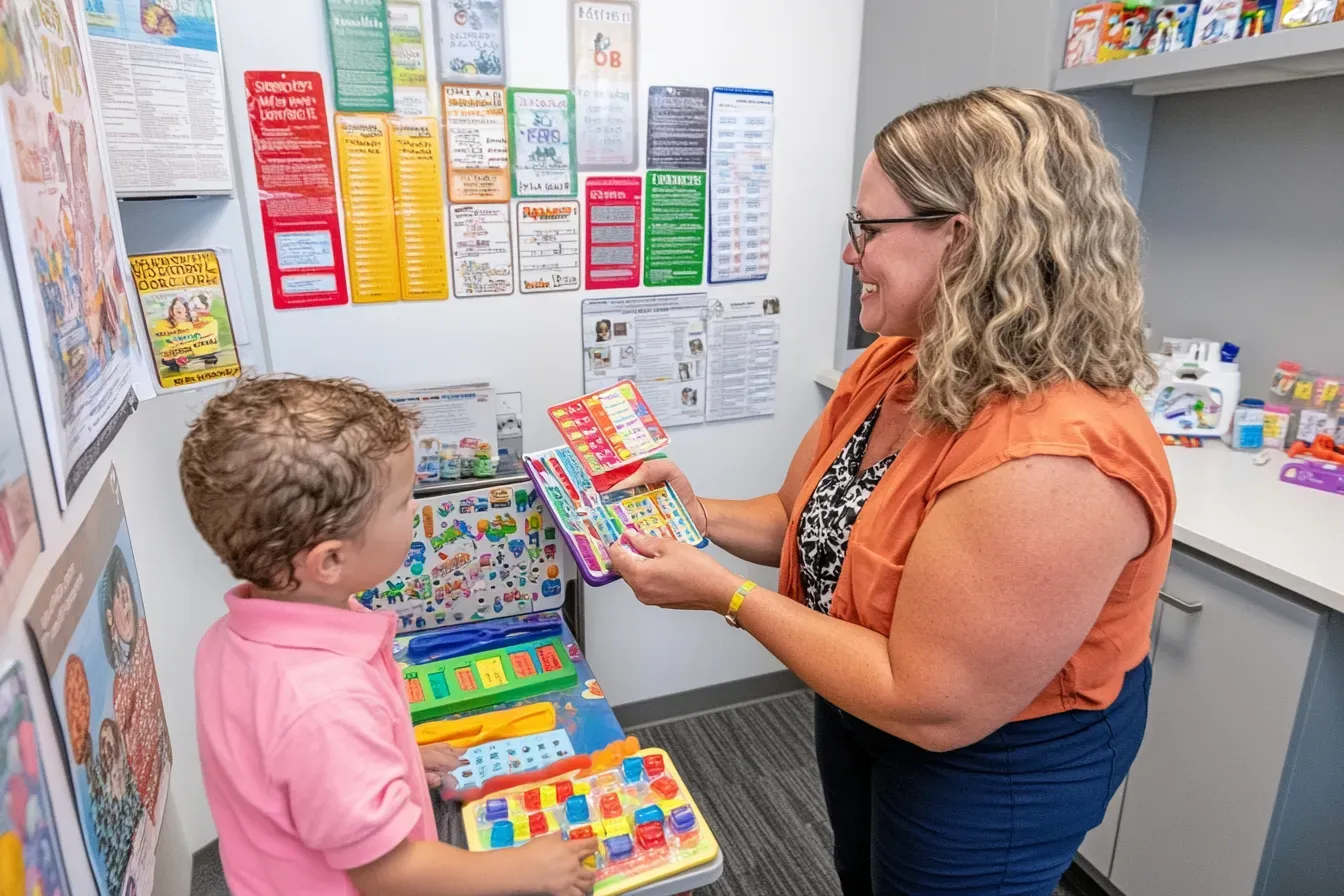How to Become a Pediatric Medical Assistant: Salary & Career Paths for 2026
Many healthcare roles are in high demand across the United States (US) due to an ongoing shortage problem. These in-demand roles include pediatric medical assistants. Generally, employment for medical assistants in the country has been predicted to have a positive job growth rate that is much faster than the average rate for all US occupations between 2023 and 2033 [US Bureau of Labor Statistics (BLS), 2024].
However, aspiring pediatric medical assistants must know that the 2023 median hourly wage of medical assistants ($20.19) is lower than that of all US occupations ($23.11) in the same year (US BLS, 2024). Notably, the role only requires a certificate or associate’s degree, which can help individuals enter the labor force and earn quicker than if they pursued a 4-year degree. Fortunately, work experience plus earning additional certifications and degrees along the way can help increase employability and income potential.
To help aspiring pediatric medical assistants get started on their healthcare careers, I created this in-depth guide that discusses academic requirements, the responsibilities that come with the role, current salary data, and available career opportunities.
What are the benefits of becoming a pediatric medical assistant?
- Individuals who finish medical assisting programs may be qualified to choose among available specializations, such as pediatrics, cardiology, dermatology, endocrinology, and gynecology.
- Medical assistants in the US had a 2023 median annual wage of $42,000 and a 2024 median annual wage of $44,200 (US BLS, 2024, 2025).
- Between 2023 and 2033, employment for medical assistants across the country has been forecasted to increase by 15%, which is much faster than the average job growth rate for all US occupations (US BLS, 2024).
Table of Contents
- What is a pediatric medical assistant and what do they do?
- What skills are required to work in pediatric healthcare?
- What education is needed to become a pediatric medical assistant in 2026?
- Are there online programs for pediatric medical assistant training?
- What certifications are best for pediatric medical assistants?
- How much does a pediatric medical assistant make?
- What is the average salary of a pediatric medical assistant by state?
- How do training costs impact the career prospects of pediatric medical assistants?
- What challenges do pediatric medical assistants typically encounter?
- Can pediatric medical assistants transition to healthcare administration?
- Can advanced management training boost career growth for pediatric medical assistants?
- How does the average salary of a pediatric medical assistant compare to related roles?
- What are the career advancement options for pediatric medical assistants?
- What is the career outlook for pediatric medical assistants?
- Everything Else You Need to Know about How to Become a Pediatric Medical Assistant
What is a pediatric medical assistant and what do they do?
Pediatric medical assistants support both healthcare providers and young patients in clinical settings. Their responsibilities combine clinical skills with a compassionate, child-friendly approach to ensure effective care. For those interested in this rewarding career path, learning how to become a National Certified Medical Assistant is a great step toward gaining the credentials and training needed to work confidently in pediatric healthcare.
The following are three core duties that a pediatric medical assistant performs:
- They prepare patients for exams. Pediatric medical assistants take vital signs, measure height and weight, and help children feel comfortable before the doctor arrives. They may also explain procedures in age-appropriate language to reduce anxiety.
- They assist during procedures. They support pediatricians during exams, vaccinations, and minor treatments. They hand over tools, calm patients, and ensure a smooth workflow in the exam room.
- They manage medical records and scheduling. Pediatric medical assistants update patient charts, input immunization records, and coordinate appointments and follow-ups to ensure that families stay informed and care remains organized.
What skills are required to work in pediatric healthcare?
Working in pediatric healthcare requires healthcare workers to have a blend of clinical competence and emotional intelligence, particularly for pediatric medical assistants (MA) who interact closely with children and their families. Understanding the difference between MA and CNA roles can also help clarify expectations, as pediatric medical assistants often handle more administrative and clinical tasks than CNAs. The following are three essential skills for success in this role:
- Strong Communication Skills: A pediatric medical assistant must explain medical procedures in ways that children can understand. They must comfort both young patients and their parents. Clear, compassionate communication helps build trust and ease anxiety.
- Patience and Empathy: Children may be fearful, restless, or nonverbal, especially when sick or in unfamiliar environments. Patience and empathy are crucial for responding calmly and supportively in these situations.
- Attention to Detail: Pediatric care often involves tracking immunizations, growth milestones, and development-related information. Accurate record-keeping and precision in clinical tasks are vital to ensure safe and effective care. To give you a leg up, you can consider taking courses in medical billing schools online accredited by national agencies.
What education is needed to become a pediatric medical assistant?
To become a pediatric medical assistant, you will need a high school diploma or GED followed by formal training through an accredited medical assistant program. These programs, offered at community colleges, vocational schools, and some universities, usually take about 9 to 12 months for a certificate or up to 2 years for an associate degree.
This makes the profession one of several healthcare jobs that don't require a college degree, offering a quicker path into the medical field. Notably, while pediatric-specific programs are rare, students can choose electives or clinical rotations in pediatric settings to gain specialized experience.
For those exploring the medical office assistant career path, focusing on pediatric electives or clinical rotations can provide specialized experience that sets you apart.
Coursework covers anatomy, medical terminology, clinical procedures, and administrative tasks. After completing a program, many aspiring pediatric medical assistants pursue certification to improve job prospects and credibility. Certification is not always required but may be preferred by many employers and may lead to higher pay. Hands-on externships are often part of the training to provide students with real-world experience in pediatric clinics.

Are there online programs for pediatric medical assistant training?
Online programs are available for medical assistant training. While they may not focus exclusively on pediatrics, many allow students to gain relevant skills applicable to pediatric care. Students exploring affordable options might also consider a low-cost medical coding and billing online program, which can complement medical assistant training with administrative expertise.
These programs usually offer flexible, self-paced coursework that cover fundamental topics in the field, such as medical terminology, patient care, and administrative procedures. Some include optional or required externships in pediatric clinics to provide hands-on experience.
Online training is ideal for those balancing work or family responsibilities, but it is important to choose an accredited program to ensure quality and eligibility for certification. For students interested in pediatrics, seeking clinical placements or electives in pediatric healthcare can help align the online experience with this specialty.
The following academic institutions offer online medical assisting programs:
- Davenport University Online Global Campus
- Barton County Community College
- University of the District of Columbia
- University of Houston
- Minnesota State College Southeast
What certifications are best for pediatric medical assistants?
Certifications can improve the job prospects, income potential, and credibility of a pediatric medical assistant. During my research for this guide, I found that the following are some certification options available to aspirants in the US:
- Certified Medical Assistant (CMA) (AAMA)®: The Certified Medical Assistant (CMA) credential is provided by the American Association of Medical Assistants (AAMA) to assess aspiring medical assistants in areas of general, clinical, and administrative responsibilities. Applicants must be students or graduates of medical assisting programs that are accredited by the Commission on Accreditation of Allied Health Education Programs (CAAHEP) or the Accrediting Bureau of Health Education Schools (ABHES). This certification examination is accredited by the National Commission for Certifying Agencies (NCCA).
- Registered Medical Assistant (RMA) Credential of the American Registry of Medical Assistants (ARMA): The ARMA also offers aspiring medical assistants the opportunity to earn the national credential of RMA. Applicants must have a high school diploma or its equivalent and may be required to submit a copy of their diploma or certificate of completion from an accredited medical assisting school.
How much does a pediatric medical assistant make?
In 2024, medical assistants in the US had a median annual wage of $44,200 and a mean annual wage of $44,720 (US BLS, 2025). Both figures increased from 2023—the role had a 2023 median annual wage of $42,000 and a 2023 mean annual wage of $ 43,350 (US BLS, 2024).
In particular, pediatric medical assistants across the country had an average annual salary of $38,376 (ZipRecruiter, 2025). Several factors influence these earnings, including the following:
- Work Experience: Seasoned professionals often command higher wages due to their expertise and efficiency.
- Education and Certification: Holding certifications, such as CMA or RMA, can enhance job prospects and salary potential, especially for those building a medical administrative assistant career.
- Geographic Location: Salaries vary by region, with urban areas or states usually offering higher pay due to increased demand and cost of living.
- Workplace Setting: Employment in outpatient care centers or hospitals may offer higher compensation compared to private practices.

What is the average salary of a pediatric medical assistant by state?
As I previously mentioned, medical assistants in the US had a median annual wage of $44,200 and a mean annual wage of $44,720 in 2024 (US BLS, 2025). Medical assistant salaries can differ significantly across states due to several key factors, including the following:
- Cost of Living: States with higher living expenses often offer higher wages to offset daily costs, such as housing and transportation.
- Demand for Healthcare Services: Areas with larger populations or more pediatric clinics usually have a greater demand for medical assistants, which can drive up salaries.
- State Funding and Healthcare Infrastructure: Regions with better-funded healthcare systems may offer more competitive wages and benefits to attract qualified professionals.
For those exploring the highest paying medical assistant jobs, it’s useful to look at the states offering the top median annual wages. To give you an example of the differences in salaries for pediatric medical assistants across the country, below are the highest-paying US states for medical assistants in 2024 in terms of median annual wages (US BLS, 2025):
- Washington: $55,120
- Alaska: $51,860
- Oregon: $49,900
- District of Columbia: $49,740
- Minnesota: $49,380
- Hawaii: $48,820
- Massachusetts: $48,540
- California: $48,050
- New Hampshire: $48,040
- Wisconsin: $47,610
The chart below provides a visualization of the 2024 median annual wages of medical assistants in top-paying states in the US, according to 2025 data from the US BLS.
How do training costs impact the career prospects of pediatric medical assistants?
Prospective pediatric medical assistants should evaluate the financial commitment of their training to ensure a strong return on investment. Various accredited programs show significant differences in tuition and ancillary fees, which can influence long-term career prospects. Analyzing program expenses alongside potential salary growth and career advancement opportunities is essential for informed decision-making. Utilizing resources that compare the cost of medical assistant program can help identify affordable yet high-quality educational options. Additionally, exploring financial aid options such as scholarships, grants, and flexible payment plans can mitigate costs and support successful career entry.
What challenges do pediatric medical assistants typically encounter?
Pediatric medical assistants often face unique challenges that require both clinical expertise and emotional resilience. They must navigate the complexities of engaging with young patients and their families, which can involve intense emotional situations and varied communication demands. Balancing clinical tasks with administrative duties may also increase the likelihood of stress and burnout if support systems and efficient workflows are not in place. Furthermore, staying current with evolving clinical practices and healthcare regulations is critical, highlighting the importance of continuous education—pursuing an online degree in healthcare can serve as a strategic step to address these challenges while enhancing career advancement opportunities.
Can pediatric medical assistants transition to healthcare administration?
Pediatric medical assistants can leverage their clinical experience to move into healthcare administration, where leadership and operational insights are highly valued. Transitioning often requires supplementing hands-on experience with targeted business and management training. Many professionals enhance their qualifications by pursuing an accelerated bachelor's degree to build expertise in healthcare finance, strategic planning, and regulatory compliance. For those considering this pathway, exploring programs such as the fastest bachelors in healthcare administration degree may provide a competitive edge and broaden career prospects.
Can advanced management training boost career growth for pediatric medical assistants?
Expanding responsibilities in healthcare demand competencies beyond clinical proficiency. Integrating advanced management training can empower pediatric medical assistants to transition into leadership roles, optimize operational processes, and navigate complex regulatory environments. This strategic educational investment may offer competitive salary enhancements and elevate professional influence within healthcare organizations. Moreover, targeted business-focused curricula provide actionable insights into healthcare finance and team leadership, making it easier to bridge clinical practice with administrative excellence. For instance, pursuing an accelerated MBA in healthcare management online sharpens these skills and aligns with long-term career ambitions.
How does the average salary of a pediatric medical assistant compare to related roles?
Salaries across healthcare roles vary based on multiple factors, reflecting differences in training, responsibilities, and patient care complexity. The following are three main reasons:
- Education and Training Requirements: Several healthcare roles, including physician assistants and nurse practitioners, require advanced degrees and certifications. This results in higher pay compared to entry-level positions, such as medical assistants, which typically require a certificate or associate degree. For those exploring options in patient care, getting a CNA certificate and license can also serve as a stepping stone into the healthcare field with minimal training time.
- Scope of Responsibilities: Healthcare professionals with broader responsibility, such as diagnosing conditions, prescribing medication, or performing procedures, tend to earn more than support staff who assist with routine clinical or administrative tasks.
- Specialization and Risk Level: Specialties, such as surgery or emergency care, often involve higher stress, risk, and skill, justifying greater compensation. Support roles in general practice or pediatrics may earn less due to narrower focus and lower associated risk.
The following data points are the 2023 or 2024 mean annual wages of medical assistants and related professional roles in the US (US BLS, 2024, 2025):
- Medical Assistant (2024): $44,720
- Licensed Practical Nurse (LPN) or Licensed Vocational Nurse (LVN) (2024): $64,150
- Physician Assistant (2024): $136,900
- Medical and Health Services Manager (2024): $137,730
- Pediatrician (2023): $205,860
- Pediatric Surgeon (2023): $449,320
The chart below provides a visualization of the 2023 or 2024 mean annual wages of professional roles related to medical assisting, according to 2024 and 2025 data from the US BLS.
What are the career advancement options for pediatric medical assistants?
Pediatric medical assistants can use their experience as a stepping stone to advance into higher-paying and more specialized healthcare roles. The following are several career paths to consider:
- Licensed Practical Nurse (LPN) or Licensed Vocational Nurse (LVN): With additional education and licensure, pediatric medical assistants can transition into nursing and specialize in pediatrics or other areas of interest. When comparing a licensed practical nurse vs medical assistant, LPNs take on more direct-patient-care responsibilities and typically earn higher salaries due to their expanded scope of practice.
- Medical and Health Services Manager: By pursuing a degree in healthcare administration, a pediatric medical assistant can move into management roles. They will oversee clinical operations in pediatric or general healthcare settings.
- Physician Assistant: This advanced role requires a master’s degree and certification, but it allows professionals to diagnose, treat, and prescribe under physician supervision.
- Pediatrician: Becoming a pediatrician is a long-term goal that requires extensive education, including medical school and residency. However, starting as a pediatric medical assistant provides valuable experience, builds clinical skills, and strengthens medical school applications. Becoming a pediatric medical assistant is a solid first step toward a high-paying, impactful career in pediatric medicine.
What is the career outlook for pediatric medical assistants?
The demand for medical assistants, including those specializing in pediatrics, is expected to grow steadily due to increasing healthcare needs across the US. Similarly, related professions, such as licensed practical nurses, physician assistants, and healthcare administrators, are projected to see robust job growth, reflecting the expanding scope of pediatric and general healthcare services.
- Medical Assistant: Employment for medical assistants is expected to increase by 15% from 2023 to 2033, which is much faster than the average job growth rate for all US occupations. This is equivalent to an average of around 119,800 job openings annually for the role during the decade (US BLS, 2024).
- Licensed Practical Nurse (LPN) or Licensed Vocational Nurse (LVN): Employment for LPNS and LVNs is expected to grow by 3% from 2023 to 2033, which is as fast as the average rate for all occupations in the country. This is equivalent to an average of around 54,000 job openings annually for the role over the decade (US BLS, 2024). For pediatric medical assistants seeking career advancement, enrolling in a medical assistant or MA to LPN bridge program online offers a flexible and accessible path to transition into this growing field.
- Medical and Health Services Manager: Employment for medical and health services managers is expected to grow by 29% from 2023 to 2033, which is significantly faster than the average rate for all occupations across the US. This is equivalent to an average of around 61,400 job openings yearly for the role over the decade (US BLS, 2024).
- Physician Assistant: Employment for physician assistants is expected to increase by 28% from 2023 to 2033, which is much faster than the average rate for all occupations across the US. This is equivalent to an average of around 12,900 job openings annually for the role during the decade (US BLS, 2024).
- Physician and Surgeon: Employment for physicians and surgeons is expected to grow by 4% from 2023 to 2033, which is as fast as the average rate for all US occupations. This is equivalent to an average of around 23,600 job openings yearly for the role over the decade (US BLS, 2024).

Here’s What Professionals Have to Say About Their Careers as Pediatric Medical Assistants
- “Becoming a pediatric medical assistant was the best decision I’ve made. Working with children every day brings so much joy, and I get to be part of their growth and health journey. The certification process was straightforward, and I landed a clinic job within a few months of graduating.” —Beth
- “I love that my role allows me to combine clinical skills with compassionate care. Watching nervous kids leave with a smile after a check-up is incredibly rewarding, and the job stability in pediatrics has made me feel secure in my career.” —Adam
- “The hands-on training in pediatrics taught me how to communicate with children of all ages, and it made me realize how impactful medical assistants can be. I’ve built strong bonds with families and feel like I truly make a difference every single day.” —Julie
Key Findings
- Pediatric medical assistants support both healthcare providers and young patients in clinical settings. Their responsibilities combine clinical skills with a compassionate, child-friendly approach to ensure effective care.
- To become a pediatric medical assistant, you will need a high school diploma or GED followed by formal training through an accredited medical assistant program. These programs, offered at community colleges, vocational schools, and some universities, usually take about 9 to 12 months for a certificate or up to 2 years for an associate degree.
- In 2024, medical assistants in the US had a median annual wage of $44,200 and a mean annual wage of $44,720 (US BLS, 2025). Both figures increased from 2023—the role had a 2023 median annual wage of $42,000 and a 2023 mean annual wage of $ 43,350 (US BLS, 2024).
- In particular, pediatric medical assistants across the country had an average annual salary of $38,376 (ZipRecruiter, 2025).
- Employment for medical assistants is expected to increase by 15% from 2023 to 2033, which is much faster than the average job growth rate for all US occupations. This is equivalent to an average of around 119,800 job openings annually for the role during the decade (US BLS, 2024).
Other Things You Should Know about How to Become a Pediatric Medical Assistant
What is the highest paid medical assistant?
The highest-paying industries for medical assistants are scientific research and development services ($55,130); junior colleges ($53,890); and grantmaking and giving services ($50,990) (US BLS, 2024). Medical assistants with additional training, work experience, and supervisory roles may also earn higher salaries than entry-level medical assistants. Therefore, aspiring medical assistants must take into consideration the several factors that determine income potential, including industry, academic background, and professional experience.
What is the biggest strength of a medical assistant?
The biggest strength of a medical assistant is their ability to seamlessly balance clinical and administrative tasks while providing compassionate patient care. Their versatility, strong communication skills, and attention to detail make them essential to keeping healthcare offices running smoothly and ensuring a positive experience for patients.
What is the best specialty for a medical assistant?
The best specialty for a medical assistant depends on professional goals and personal interests. Notably, pediatrics, dermatology, cardiology, and orthopedics are popular choices. Pediatrics is ideal for those who enjoy working with children, while cardiology and orthopedics offer higher pay and opportunities to develop advanced clinical skills in specialized care settings.
What is the most important role of the medical assistant in the clinical setting?
The most important role of a medical assistant in the clinical setting is supporting patient care by performing vital tasks, including taking medical histories, checking vital signs, and assisting with exams. Their efficiency and empathy help ensure smooth clinical operations and enhance the overall patient experience.
References:
- National Center for Education Statistics. (2024, May). Undergraduate Degree Fields. https://nces.ed.gov/programs/coe/indicator/cta
- US Bureau of Labor Statistics. (2024, August 29). Licensed Practical and Licensed Vocational Nurses. Occupational Outlook Handbook. https://www.bls.gov/ooh/healthcare/licensed-practical-and-licensed-vocational-nurses.htm
- US Bureau of Labor Statistics. (2024, April 03). May 2023 National Occupational Employment and Wage Estimates, United States. Occupational Employment and Wage Statistics. https://www.bls.gov/oes/2023/may/oes_nat.htm
- US Bureau of Labor Statistics. (2024, August 29). Medical and Health Services Managers. Occupational Outlook Handbook. https://www.bls.gov/ooh/management/medical-and-health-services-managers.htm
- US Bureau of Labor Statistics. (2024, August 29). Medical Assistants. Occupational Outlook Handbook. https://www.bls.gov/ooh/healthcare/medical-assistants.htm
- US Bureau of Labor Statistics. (2024, April 03). Occupational Employment and Wages, May 2023, 11-9111 Medical and Health Services Managers. Occupational Employment and Wage Statistics. https://www.bls.gov/oes/2023/may/oes119111.htm
- US Bureau of Labor Statistics. (2024, April 03). Occupational Employment and Wages, May 2023, 31-9092 Medical Assistants. Occupational Employment and Wage Statistics. https://www.bls.gov/oes/2023/may/oes319092.htm
- US Bureau of Labor Statistics. (2025). May 2024 OEWS Profiles. Occupational Employment and Wage Statistics (OEWS) Profiles. https://data.bls.gov/oesprofile
- US Bureau of Labor Statistics. (2024, August 29). Physicians and Surgeons. Occupational Outlook Handbook. https://www.bls.gov/ooh/healthcare/physicians-and-surgeons.htm
- US Bureau of Labor Statistics. (2024, August 29). Physician Assistants. Occupational Outlook Handbook. https://www.bls.gov/ooh/healthcare/physician-assistants.htm
- ZipRecruiter. (2025, April 10). Pediatric Medical Assistant Salary. https://www.ziprecruiter.com/Salaries/Pediatric-Medical-Assistant-Salary#Yearly


































